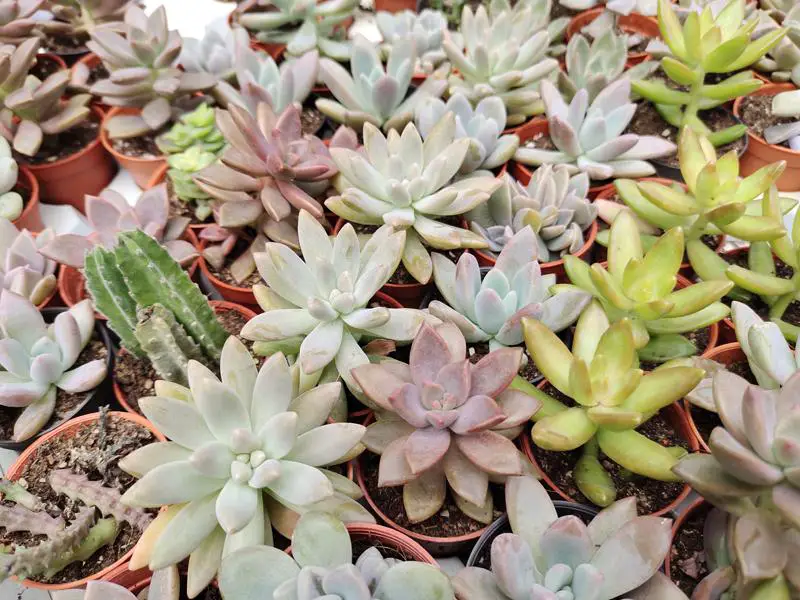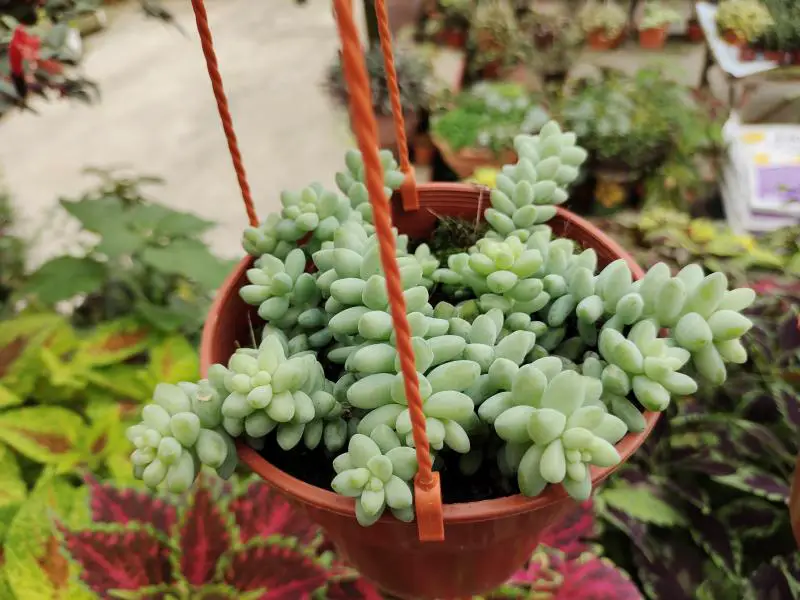Succulents tend to be the first choice of plants chosen by beginners. As of now, there are many different kinds of succulents you can choose from.
However, do you ever have any “misunderstanding” about these simple-to-raise, easy-to-get plants? This included things like radiation, air purifying, watering, and many others. We often seem to forget that succulent is a plant, instead of an inorganic ornament.
To understand more about succulents, I have compiled some of the most common myths about raising succulents for you. You may get these things right so you won’t treat them the wrong way anymore.
1. Not All Succulents Are Suitable For Indoors
Succulents are often used as office ornaments and houseplants. But we need to know that succulents are native to arid areas, therefore, not all succulents are suitable to be planted indoors.
We should say that most succulents are more suitable for outdoor environments, especially those with bright colors. They need more sunlight to survive. Insufficient sunlight can easily lead to poor growth and eventually death.
Those succulents that are more suitable for indoor growth are crown of thorns, jade plant, aloe vera, zebra cactus, etc.
It is recommended to confirm their sunlight needs before purchasing. If you don’t have a balcony or backyard, you can place your plants close to your windowsill so that your succulents can receive the most sunlight while placed indoors.
2. There Is No Such Thing As “Absorbing Radiation”
We’ve heard more or less that a succulent or cactus can “absorb radiation” when placed next to a computer or laptop. If you have left a succulent next to your computer for a long time, and think it helps you to absorb radiation, I’m sorry to say that this just didn’t happen.
This is just a myth! Succulents do not have this magical effect. The National Health and Welfare Administration has refuted the rumor and announced that “succulents cannot absorb computer radiation”, and pointed out that the extremely low-frequency non-ionizing radiation of computers cannot be absorbed by succulents.
Is, no plant can absorb radiation. But we don’t have to worry too much about the adverse effects of radiation from electronic products on our health, because the current regulations in most countries have properly regulated the electromagnetic wave limit values of electronic products.
3. Air Purifying With Succulents
In addition to “absorbing radiation”, another succulent myth is “purifying the air”. According to an article in National Geographic that cleaning indoor air is practically “impossible”.
Richard Corsi, who studies air pollution, said: “Indoor plants can do as much to clean the air as a few pairs of old socks or baseball caps that are hanging on a wall.”
The range of air that succulents or other indoor plants can purify is very small. According to experts’ measurements, purifying the air quality of your room, it may require “more than 100 plants per square meter” to make it possible.
NASA Clean Air Study
The NASA Clean Air Study did study the air purification efficiency of snake plants, but the study did not indicate that it can be effective for all indoor environments. You can refer to this: NASA Clean Air Study
NASA’s research has long been clarified. They are carrying the research on plants in very small spaces (like in a spaceship). The research results are not suitable for ordinary indoors.
If you want to achieve the effect of purifying the air, you cannot rely on plants.
Many people believe that plants can really purify the air, and even have the ability to maintain physical health and protect eyesight, etc.
However, they do not know that opening windows for ventilation and using fewer electronic products are more practical than plants.
4. Succulents Can Survive Without Watering
Although a succulent is drought-tolerant, it is still a plant and still needs water. In terms of frequency, if it is kept outdoors and has sufficient sunshine, it is recommended to water it once a week; if it is not ventilated, it needs to be watered once every two weeks; indoor planting with less sunlight can even be watered once every 3-4 weeks.
During the “growing season”, like during the summertime, water can be poured all at once until the water flows out of the holes at the bottom of the container. While in the non-growing season, the amount of water can be halved or reduced to one-third.
Note that when watering, try not to let the water stay on the stems and leaves, which is easy to cause rot.
It is not advisable to water succulents outdoors at noon in the summer, because the temperature difference can be extreme. If the water droplets are not dry, it may cause “leaf burn”.
Some succulents are watered “seasonally”. For example, the special-looking Lithops should be watered after the old leaves die in late spring. After all, there are too many varieties of “succulents” in this world, you can’t treat them all the same way. That’s also the main reason why many succulents failed to grow by beginners.
5. Raise Succulents in Glass Containers
The choice of containers for plants is very important. Many people now keep their succulents in glass containers. Although it looks beautiful, the drainage can be an issue. This may make the succulent roots unable to “breathe” well, resulting in unhealthy stems and leaves, and causing pests and diseases.
A glass container can heat up quickly but dissipates heat slowly, so it is difficult to measure the amount of sunlight for the succulents.
Therefore, it is recommended that beginners use pots with good drainage and ventilation such as pottery. If you want to use glass pots, you have to seek advice from the store that helps you set up the pots and ask them how to take care of the succulents properly.
6. All Succulents Are Going Through the Same Photosynthesis
Most succulents absorb carbon dioxide by photosynthesis during the day. But some desert plants are exceptions. They are called Crassulacean Acid Metabolism plants, or CAM plants. They breathe carbon dioxide and release oxygen at night.
CAM plants like snake plants can indeed open their stomata to absorb carbon dioxide at night, but since there is no light for photosynthesis, so at night it is impossible for the plant to release oxygen.
CAM plants store the carbon dioxide absorbed at night and use it for photosynthesis during the day, so it still has to release oxygen during the day.
7. No Succulents Can Survive in Cold Temperatures
This is not true. Not all succulents cannot survive in cold temperatures. Succulents like agave and jade plants can actually endure extremely cold temperatures as low as 33 degrees Fahrenheit.
Commonly, we all think that succulents are plants that are flourishing in hot and arid areas. They are plants that store water in their leaves, stems, and roots. Certain succulents, however, are very tough and can withstand low temperatures of 33 degrees Fahrenheit. Just two examples of succulents that can endure freezing temperatures are agave and jade plants.
When exposed to cold weather, succulents will go dormant and consume less water, but as long as the temperature is above freezing, the plants should be able to survive. If you live in an area with chilly winters, bring your succulents inside or cover them with blankets to keep them safe from frost and below-freezing temperatures.
8. Succulents No Need Pruning
No, succulents do require pruning to maintain their shape and remove any dead or diseased foliage. Pruning also encourages new growth and helps to keep succulents looking neat and tidy.
9. Succulents Don’t Need to be Rotated
This is not true. Succulents need actually be rotated frequently. When kept in a single location for an extended period of time, succulents, a type of plant that needs a modest amount of light to develop and thrive, might experience stress and a lack of sunlight. Regular rotation of succulents ensures that all of their surfaces receive an equal amount of light and keeps them from growing too uneven or strained.
Succulents can become stretched in the direction of the light source, giving them an uneven appearance. Rotating succulents helps to keep their symmetrical shape. The succulent may become stretched in one way if it is left in the same location for an extended period of time and receives more light on one side than the other. This can be avoided by rotating succulents every few days or weeks.
Also, rotating succulents makes sure they get enough ventilation, which is necessary for their health. The plant may become stressed and ill if they are left in the same place all the time since the ventilation may be obstructed, resulting in stagnant air and increased humidity. By routinely rotating them, you can maintain the plant healthy by ensuring that the air can circulate around it.
10. Succulents Are All Cacti
The answer may surprise you! Contrary to popular belief, not all succulents are cacti. While they share some similar characteristics—namely their ability to store water within their tissues—succulents come in many different shapes and sizes with varying degrees of hardiness. In fact, there are over 60 plant families that contain both cactus and succulent species!
Succulents can provide us with beauty, texture, color variations, and drought tolerance; however, understanding when something is truly cactus or simply a succulent is key for successful gardening endeavors. We need to know that most succulents lack thorns or hairs along their stems, while cacti have many sharp spines along their stems. Besides, cacti are more at home in arid environments like deserts, while succulents are just as at home in the humid tropics.
These are some myths about succulents and I hope after reading this post, you will be able to have a better idea of succulents and avoid blindly believing in these plants.


